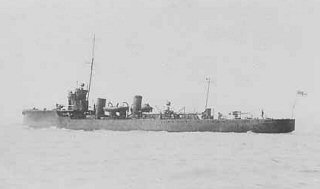Top Qs
Timeline
Chat
Perspective
Acheron-class destroyer
Class of twenty-three destroyers of the British Royal Navy, completed between 1911 and 1912 From Wikipedia, the free encyclopedia
Remove ads
The Acheron class (renamed the I class in October 1913) was a class of twenty-three destroyers of the British Royal Navy, all built under the 1910–11 Programme and completed between 1911 and 1912, which served during the First World War. There was considerable variation between the design and construction of ships within this class, which should be considered as more of a post-build grouping than a homogeneous class.[Note 1]
Remove ads
Design
Originally, 20 ships, including Acheron, were ordered but three more were completed by Yarrow & Company. The Acherons were generally repeats of the preceding Acorn- or H-class, although Acheron and five others were builders' specials. They differed from the Acorns in having only two funnels, both of which were short, the foremost being thicker than the after stack. The 12-pounder guns were mounted slightly further forward than in the Acorns.
Remove ads
Variation within the class
Summarize
Perspective
Fourteen of the class were completed to an Admiralty standard design, although those built by John Brown and Company at Clydebank (Hind, Hornet and Hydra) had Brown-Curtis type turbines and only two shafts. Archer and Attack used steam at higher pressures and Badger and Beaver were completed with geared steam turbines for evaluation purposes, achieving speeds of 30.7 kn (56.9 km/h; 35.3 mph) in trials.[2]
Thornycroft specials
Acheron and Ariel were longer (253 ft (77 m)), had higher power (15,500 shp) and were faster, achieving 29.4 kn (54.4 km/h; 33.8 mph) in trials.[2]
Yarrow specials (or "special I class")
Sir Alfred Yarrow maintained that it was possible to build strong, seaworthy destroyers with a speed of 32 kn (59 km/h; 37 mph), and eventually a contract for three such boats was placed with the firm. They were a little larger than the rest of the class and developed 20,000 shp (15,000 kW), but carried the same armament. Like the John Brown-built boats Hind, Hydra and Hornet, they had only 2 shafts, with steam developed in 2 Yarrow-type water-tube boilers and delivered to 2 Parsons turbines.[1] Firedrake, Lurcher and Oak were distinctive in appearance and indeed much faster. They all exceeded their contract speed, Lurcher making over 35 kn (65 km/h; 40 mph).
Remove ads
Conversion to minelayers
Ferret, Sandfly and Ariel were converted into fast minelaying destroyers in 1917, serving with the 20th Flotilla. They were each capable of laying 40 mines.[3]
Evaluation
This class of torpedo boat destroyers (TBDs, or colloquially, "boats") handled well and were excellent sea boats; like similar classes of TBDs of the time, they had open bridges but were much drier at sea than was the norm.
Ships
Builders' I class
Admiralty I class
Yarrow Specials (or "Special I class")
Remove ads
Notes
- No class of ships were called J class.
References
Bibliography
Wikiwand - on
Seamless Wikipedia browsing. On steroids.
Remove ads

